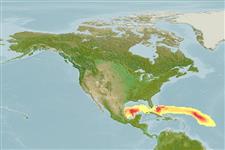Classificação / Names
Nomes comuns | Sinônimos | Catalog of Fishes(Gênero, Espécies) | ITIS | CoL | WoRMS | Cloffa
>
Scombriformes (Mackerels) >
Caristiidae (Manefishes)
Etymology: Platyberyx: Name from the Greek 'platy' meaning flat and Beryx, a genus of beryciform fishes; pietschi: Named for Dr. Theodore W. Pietsch.
Eponymy: Dr Theodore ‘Ted’ Wells Pietsch III (d: 1945) was a professor of ichthyology at the University of Washington, Seattle (1978 onwards) and is an American systematist and evolutionary biologist especially known for his studies of anglerfishes. [...] (Ref. 128868), visit book page.
Environment: milieu / climate zone / depth range / distribution range
Ecologia
marinhas batipelágico; intervalo de profundidade 1 - 750 m (Ref. 94277). Tropical
Central Pacific, Southwestern Pacific and Northwestern Atlantic.
Tamanho / Peso / Idade
Maturity: Lm ? range ? - ? cm
Max length : 9.3 cm SL macho/indeterminado; (Ref. 94277)
Descrição suscinta
Chaves de identificação | Morfologia | Morfometria
Raios dorsais (total) : 30 - 31; Raios anais : 18 - 19; Vértebras: 33 - 35. This species is distinguished from its congeners by having an anteriorly directed hook-like process on the third posteriormost ventral procurrent caudal ray; differs from P. paucus by having greater number of dorsal-fin rays (30-31 vs. 24-26), anal-fin rays (18-19 vs. 15-16), pectoral-fin rays (17-18 vs. 16-17), and vertebrae (33-35 vs. 31); differs from P. andriashevi by having fewer dorsal-fin rays (30-31 vs. 31-37), anal-fin rays (18-19 vs. 19-22), and vertebrae (33-35 vs. 36-39); differs further from P. opalescens by having small bristles and larger spikes on the gill rakers (vs. small bristles only), and from P. rhyton and P. mauli by the greater prepectoral (>39% SL vs. <36% SL) and prepelvic (>36% SL vs. <33% SL) length, shorter dorsal-fin base (<70% SL vs. >75% SL), and smaller mouth (upper jaw extending to midorbit vs. posterior margin of orbit) (Ref. 94277).
Ciclo de vida ou comportamento de acasalamento
Maturidade | Reprodução | Desova | Ovos | Fecundidade | Larvas
Stevenson, D.E. and C.P. Kenaley, 2013. Revision of the manefish genera Caristius and Platyberyx (Teleostei: Percomorpha: Caristiidae), with description of five new species. Copeia 2013(3):415-434. (Ref. 94277)
Status na Lista Vermelha da UICN (Ref. 130435: Version 2024-1)
Ameaça para os humanos
Harmless
Uso pelos humanos
Ferramentas
Relatórios especiais
Baixar XML
Fontes da internet
Estimates based on models
Preferred temperature (Ref.
123201): 13.2 - 23.6, mean 19 °C (based on 13 cells).
Índice de diversidade filogenética (Ref.
82804): PD
50 = 0.5156 [Uniqueness, from 0.5 = low to 2.0 = high].
Bayesian length-weight: a=0.02455 (0.00947 - 0.06362), b=3.00 (2.78 - 3.22), in cm total length, based on LWR estimates for this (Sub)family-body shape (Ref.
93245).
Nível Trófico (Ref.
69278): 3.4 ±0.5 se; based on size and trophs of closest relatives
Fishing Vulnerability (Ref.
59153): Low vulnerability (10 of 100).
